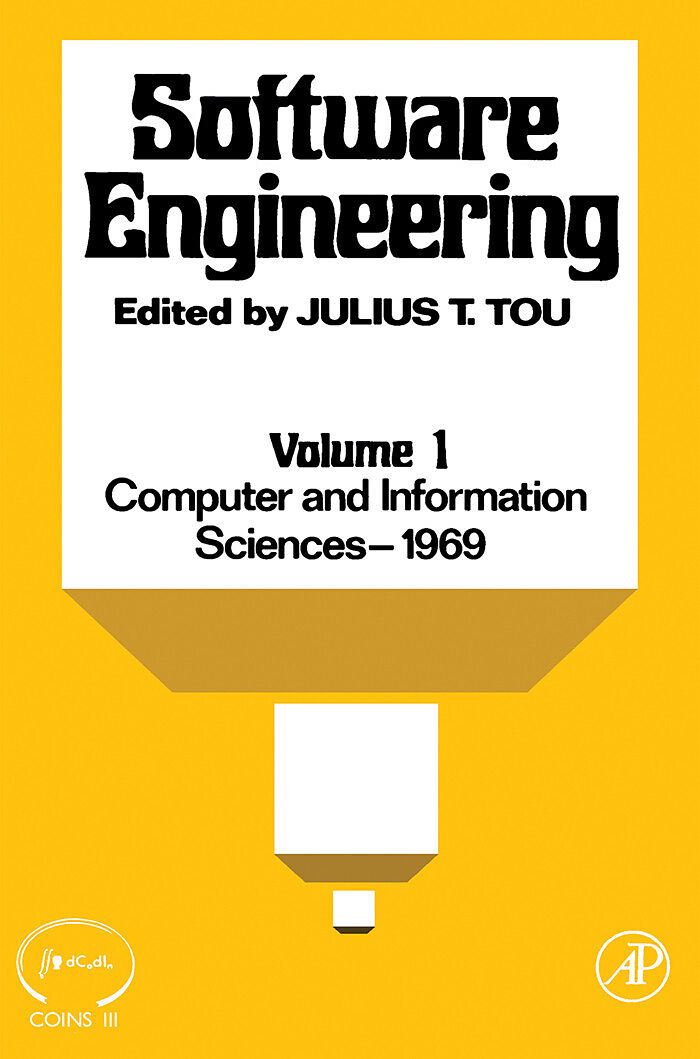Software Engineering
Einband:
E-Book (pdf)
EAN:
9780323157445
Untertitel:
Proceedings of the Third Symposium on Computer and Information Sciences held in Miami beach, Florida, December, 1969
Genre:
Informatik, EDV
Herausgeber:
Elsevier Science & Techn.
Anzahl Seiten:
288
Erscheinungsdatum:
02.12.2012
Software Engineering, Volume I is a compilation of the proceedings of the Third Symposium on Computer and Information Sciences held in Miami Beach, Florida, on December 18-20, 1969. The papers explore developments in software engineering and cover topics ranging from computer organization to systems programming and programming languages.
This volume is comprised of 15 chapters and begins with an overview of the emergence of software engineering as a profession, followed by a discussion on computer systems organization. A virtual processor for real-time job or transaction control is then described, along with the architecture of the B-6500 computer. Subsequent chapters focus on the use and performance of memory hierarchies; the use of extended core storage in a multiprogramming operating system; methods of improving software development; and techniques for automatic program translation. The final chapter considers the extensibility of FORTRAN.
This book is intended for scientists, engineers, and educators in the field of computer and information science.
Inhalt
List of Contributors to Volume 1
Preface
Acknowledgments
The Challenge for the 1970s in Information Retrieval
Contents of Volume 2
List of Contributors to Volume 2
Software Engineering-A New Profession
Ideas for Computer Systems Organization: A Personal Survey
I. Introduction
II. Partitioning of Storage Space
III. Partitioning of Processing Time
IV. A Machine Language for Expressions and Procedures
V. Structured Programming: The Elimination of Branches
VI. Iteration and Vector Programming
VII. Program Definable Storage Mappings
VIII. Final Comments
References
A Virtual Processor for Real Time Operation
I. Introduction
II. Storage Organization
III. User Control
IV. Creation of Processes
V. Activation of Processes
VI. Interprocess Communication
VII. The File Store
VIII. Input/Output
IX. Summary
X. Conclusions
References
Architecture of the B-6500
I. Introduction
II. Design Team
III. Design Principles
IV. Significant Architectural Features of B-6500
V. Conclusion
References
The Use and Performance of Memory Hierarchies: A Survey
I. Introduction
II. Page Fault Rate
III. Multiprogramming
IV. Average Time per I/O Request
V. Summary and Extensions
References
The Use of Extended Core Storage in a Multiprogramming Operating System
I. Introduction
II. Factors Influencing Throughput
III. Design Objectives
IV. Implementation
V. Performance Statistics
VI. Future Improvements
VII. Expected Gains
References
Uniform Referents: An Essential Property for a Software Engineering Language
I. Introduction
II. Programming Language: The Math of Software
III. Outside-In Problem Statement
IV. An Example
V. A Graph Model Representation
VI. Interlevel Connection by Interfaces
VII. The Requirement for Uniform Referents
VIII. Conclusion
References
Perspective on Methods of Improving Software Development
I. Introduction
II. Definition of Programming Effectiveness
III. Techniques for Improving Software Development
IV. Summary
References
Manageable Software Engineering
I. Introduction
II. What Should Be Produced?
III. Should it Be Produced?
IV. Can It Be Produced?
V. How Should the Producer Be Organized?
VI. How Should the Product Be Tested?
VII. How Should the Product Be Introduced?
VIII. How Should the Product Be Improved and Serviced?
IX. Conclusion
References
Generalized Interpretation and Compilation
I. Introduction
II. Comparison and Contrast
III. Examples and Consequences
References
Techniques for Automatic Program Translation
I. Introduction
II. The PILER System
III. Interpreter
IV. Analyzer
V. Converter
VI. Conclusion
References
Input/Output for a Mobile Programming System
I. The Mobile Programming System
II. The Input/Output Package
References
CASSANDRE: A Language to Describe Digital Systems, Application to Logic Design
I. Introduction
II. Notions on the Language
III. Planned Utilization of the Language CASSANDRE
IV. The System CASSANDRE
References
A Kernel Approach to System Programming: SAM
I. Introduction
II. Language Type, LP 70
III. Basic Notions: Parallelism
IV. File System
V. Measuring and Debugging Tools
VI. Conclusion
Appendix A
Appendix
References
On the Extensibility of FORTRAN
I. Introduction
II. Justifications
III. Interval Arithmetic
IV. Miscellaneous FORTRAN Language Extensions
V. Proposed Extensions to HUNK
VI. Conclusions
References
Index

Leider konnten wir für diesen Artikel keine Preise ermitteln ...
billigbuch.ch sucht jetzt für Sie die besten Angebote ...
Die aktuellen Verkaufspreise von 6 Onlineshops werden in Realtime abgefragt.
Sie können das gewünschte Produkt anschliessend direkt beim Anbieter Ihrer Wahl bestellen.
Loading...
Die aktuellen Verkaufspreise von 6 Onlineshops werden in Realtime abgefragt.
Sie können das gewünschte Produkt anschliessend direkt beim Anbieter Ihrer Wahl bestellen.
| # | Onlineshop | Preis CHF | Versand CHF | Total CHF | ||
|---|---|---|---|---|---|---|
| 1 | Seller | 0.00 | 0.00 | 0.00 |
